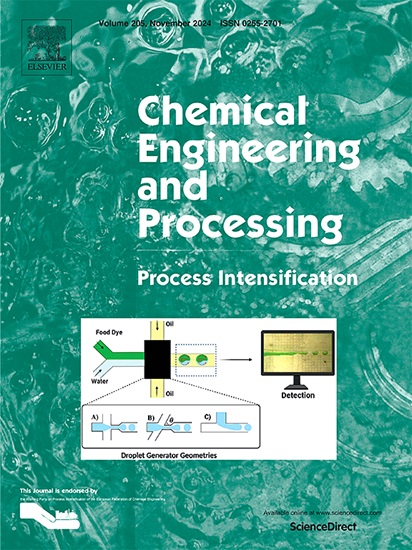Comprehending the effect of functionalized silica nanoparticles on amine blends for efficient carbon capture from synthetic flue gas
IF 3.8
3区 工程技术
Q3 ENERGY & FUELS
Chemical Engineering and Processing - Process Intensification
Pub Date : 2025-07-06
DOI:10.1016/j.cep.2025.110437
引用次数: 0
Abstract
Amine-based absorbent was conventionally used for carbon capture, but its utility is limited owing to high-temperature operability, energy-intensive regeneration, lower recyclability, and corrosion issues. In this work, amine-derived nanoformulation is prepared using functionalized silica nanoparticles (fNPs), ethylene glycol, and conventional amines by a three-step preparation technique, followed by nanofluid stability and rheological studies. Rheological observations have shown viscosity decreases with temperature, and functionalized DEA (fDEA) has indicated viscous dominant behavior at 303 K and elastic dominant behavior at 323 K, and viscoelastic and viscous behavior for DEA at 303 and 323 K. Absorption experiments were conducted in an interfacial contact reactor using synthetic flue gas (CO2: N2–1:3 molar) at 303 and 323 K using water, water+functionalized nanoparticle, fDEA nanofluid, and conventional DEA (30 vol %) solution. fDEA demonstrates ∼8 % and ∼12 % higher molar absorption than DEA solution at 303 and 323 K. Moreover, fDEA has demonstrated ∼20 % and ∼25 % higher CO2 capture efficiency (E30) than DEA solution at 303 and 323 K, respectively. Recyclability testing up to 3 cycles have shown better regeneration performance of fDEA than DEA. The superior absorption performance of fDEA for multiple cycles is attributed to additives and efficient micromixing during absorption and regeneration. This approach, in combination with other reactor contact strategies, will have an encouraging potential to capture CO2 at industrial scales from high-temperature flue gas streams.

了解功能化二氧化硅纳米颗粒对胺共混物对合成烟气高效碳捕集的影响
胺基吸收剂通常用于碳捕获,但由于高温可操作性、能源密集型再生、低可回收性和腐蚀问题,其应用受到限制。在这项工作中,利用功能化二氧化硅纳米颗粒(fNPs)、乙二醇和传统胺,通过三步制备技术制备了胺衍生的纳米制剂,随后进行了纳米流体稳定性和流变学研究。流变学观察表明,粘度随温度的升高而降低,功能化DEA (fDEA)在303 K下表现为粘性主导行为,在323 K下表现为弹性主导行为,在303和323 K下表现为粘弹性和粘性行为。在界面接触反应器中,采用水、水+功能化纳米颗粒、fDEA纳米流体和常规DEA (30 vol %)溶液,在303和323 K下使用合成烟气(CO2: N2-1:3 mol / l)进行吸附实验。在303和323 K时,fDEA比DEA溶液的摩尔吸收率高~ 8%和~ 12%。此外,在303和323 K下,fDEA的二氧化碳捕获效率(E30)分别比DEA溶液高20%和25%。3次循环的可回收性试验表明,fDEA的再生性能优于DEA。fDEA具有优异的多循环吸收性能,这主要归功于添加剂的加入和吸收再生过程中高效的微混合。这种方法与其他反应器接触策略相结合,将具有令人鼓舞的潜力,可以在工业规模上从高温烟气流中捕获二氧化碳。
本文章由计算机程序翻译,如有差异,请以英文原文为准。
求助全文
约1分钟内获得全文
求助全文
来源期刊
CiteScore
7.80
自引率
9.30%
发文量
408
审稿时长
49 days
期刊介绍:
Chemical Engineering and Processing: Process Intensification is intended for practicing researchers in industry and academia, working in the field of Process Engineering and related to the subject of Process Intensification.Articles published in the Journal demonstrate how novel discoveries, developments and theories in the field of Process Engineering and in particular Process Intensification may be used for analysis and design of innovative equipment and processing methods with substantially improved sustainability, efficiency and environmental performance.

 求助内容:
求助内容: 应助结果提醒方式:
应助结果提醒方式:


